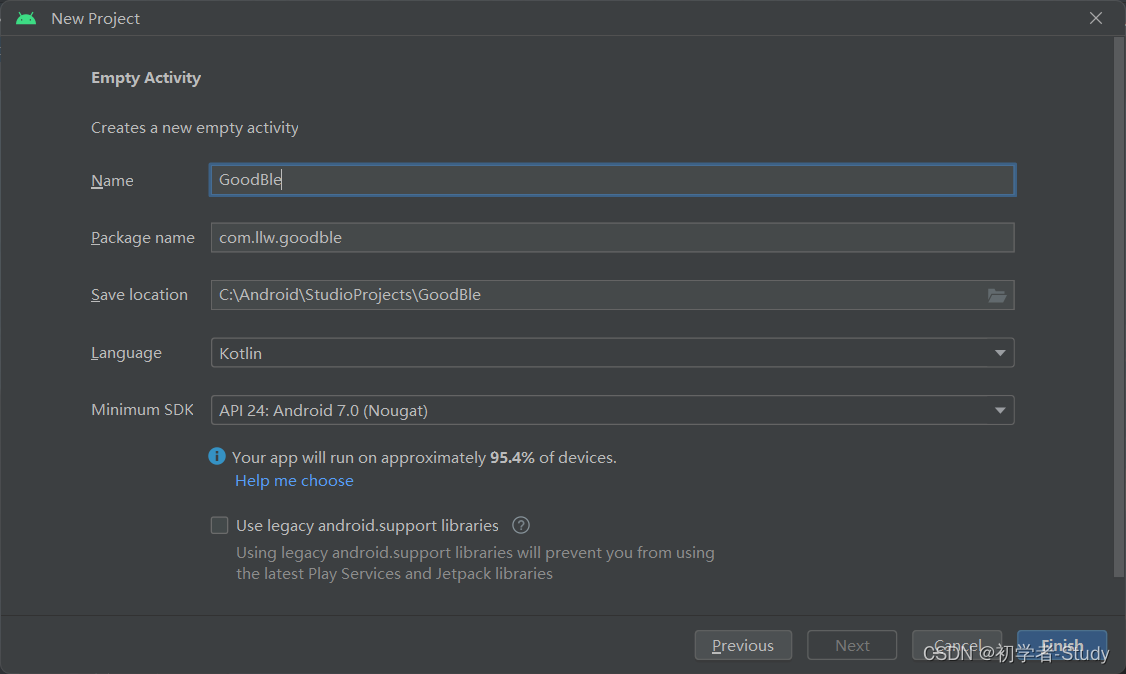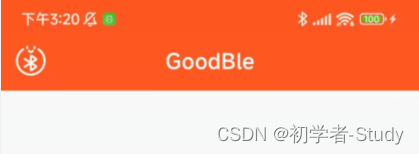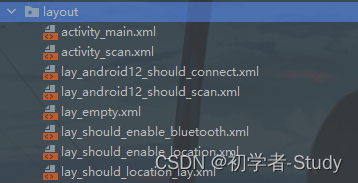温馨提示:这篇文章已超过419天没有更新,请注意相关的内容是否还可用!
摘要:本篇文章介绍了关于Android平台上的Ble蓝牙App的扫描功能。该App具备强大的蓝牙扫描能力,能够搜索并连接附近的蓝牙设备。通过简单的操作,用户可以轻松实现设备的发现和配对,为数据传输和通信提供了便捷的途径。该App的扫描功能为用户提供了高效的蓝牙设备管理体验。
Ble蓝牙App(一)扫描
- 前言
- 目录
- 正文
- 一、基本配置
- 二、扫描准备
- 三、扫描页面
- ① 增加UI布局
- ② 点击监听
- ③ 扫描处理
- ④ 广播处理
- 四、权限处理
- 五、扫描结果
- ① 列表适配器
- ② 扫描结果处理
- ③ 接收结果
- 六、源码
前言
关于低功耗的蓝牙介绍我已经做过很多了,只不过很多人不是奔着学习的目的去的,拿着源码就去运行,后面又发现连接设备后马上断开,然后不会自己看问题,这个现象就是快餐式的,你不了解里面的知识内容,自然就不知道是怎么回事,重复的问题我回答了好多次了。而我也是觉得写的有问题,本意上来说我是希望读者可以参考来写,能看一看文章内容,而结果绝大多数,看个标题看个运行效果,下载源码就运行,运行有问题就问你,没有什么思考。
针对这个情况,我决定做了系列性的Ble蓝牙App,尽可能的避免在你运行的时候出现bug,所以这是一个低功耗蓝牙工具App,可以让你了解到一些东西。注意是低功耗,不是经典蓝牙,如果你不知道两者之间的区别,建议你先了解一下。本文的效果:

App下载地址:GoodBle
目录
- Ble蓝牙App(一)扫描
- Ble蓝牙App(二)连接与发现服务
- Ble蓝牙App(三)特性和属性
- Ble蓝牙App(四)UI优化和描述符
- Ble蓝牙App(五)数据操作
正文
本文将会重新创建一个项目,功能一个一个的做,尽量的做好每一个功能的优化,下面我们创建一个名为GoodBle的项目,语言为Kotlin。

至于为什么使用Kotlin,稳固一下,不然太久不用就会生疏,文本我们讲述的是扫描,你可能回想,一个扫描有什么好写,不就是开始、结束、显示设备嘛?至于单独作为一个功能来写一篇文章嘛?那么我们带着问题来看这篇文章,看看扫描到底有没有必要这样来做。
一、基本配置
当前我们创建项目有一个MainActivity,然后我们需要打开viewBinding的开关,在app的build.gradle中的android{}闭包中添加如下代码:
buildFeatures { viewBinding true }然后Sync Now,同步一下,开启成功。随后我们就可以在Activity中使用ViewBinding了,常规的使用方式是这样的:
class MainActivity : AppCompatActivity() { private lateinit var binding: ActivityMainBinding; override fun onCreate(savedInstanceState: Bundle?) { super.onCreate(savedInstanceState) binding = ActivityMainBinding.inflate(layoutInflater); setContentView(binding.root) } }在Java中封装通常采用反射的方式,在Kotlin中如果要对ViewBinding进行封装的话同时利用上Kotlin的一些特性的话,可以这样做,原文地址如下:Viewbinding使用和委托封装,感觉写得蛮好的,太久没用Kotlin了,还是看了一会才看懂,感兴趣的可以看看。
那么我们在com.llw.goodble下面创建一个base包,base包下创建BaseViewBinding.kt文件,里面的代码如下所示:
package com.llw.goodble.base import android.app.Activity import android.view.LayoutInflater import androidx.viewbinding.ViewBinding import kotlin.properties.ReadOnlyProperty import kotlin.reflect.KProperty fun viewBinding(viewInflater: (LayoutInflater) -> VB): ReadOnlyProperty = ActivityViewBindingProperty(viewInflater) class ActivityViewBindingProperty( private val viewInflater: (LayoutInflater) -> VB ) : ReadOnlyProperty { private var binding: VB? = null override fun getValue(thisRef: Activity, property: KProperty): VB { return binding ?: viewInflater(thisRef.layoutInflater).also { thisRef.setContentView(it.root) binding = it } } }通过委托的方式进行封装,下面来看在MainActivity中怎么使用它,
class MainActivity : AppCompatActivity() { private val binding by viewBinding(ActivityMainBinding::inflate) override fun onCreate(savedInstanceState: Bundle?) { super.onCreate(savedInstanceState) setContentView(R.layout.activity_main) } }使用起来很简单,后面就采用这种方式,你可以运行一下,看看有没有问题,然后我们可以再创建一个ScanActivity类,用于扫描页面,修改一下activity_main.xml中的代码,如下所示:
这里用到了图标,代码如下所示:
颜色值,在colors.xml中增加:
#FF5722 #FFC107 #FF9800 #FFF3E0 #F8F8F8 #989898这里给toolbar设置导航图标,点击这个导航到扫描页面,不过再次之前我们可以在base包下再创建一个BaseActivity,这里面可以写一些常用的函数,代码如下所示:
open class BaseActivity : AppCompatActivity() { private var context: Context? = null override fun onCreate(savedInstanceState: Bundle?) { super.onCreate(savedInstanceState) context = this } protected fun jumpActivity(clazz: Class?, finish: Boolean = false) { startActivity(Intent(context, clazz)) if (finish) finish() } protected fun back(toolbar: Toolbar, finish: Boolean = false) = toolbar.setNavigationOnClickListener { if (finish) finish() else onBackPressed() } protected fun showMsg(msg: CharSequence) = Toast.makeText(context, msg, Toast.LENGTH_SHORT).show() protected open fun isAndroid12() = Build.VERSION.SDK_INT >= Build.VERSION_CODES.S protected open fun hasAccessFineLocation() = hasPermission(Manifest.permission.ACCESS_FINE_LOCATION) protected open fun hasCoarseLocation() = hasPermission(Manifest.permission.ACCESS_COARSE_LOCATION) @RequiresApi(Build.VERSION_CODES.S) protected open fun hasBluetoothConnect() = hasPermission(Manifest.permission.BLUETOOTH_CONNECT) @RequiresApi(Build.VERSION_CODES.S) protected open fun hasBluetoothScan() = hasPermission(Manifest.permission.BLUETOOTH_SCAN) /** * 检查是有拥有某权限 * * @param permission 权限名称 * @return true 有 false 没有 */ protected open fun hasPermission(permission: String) = checkSelfPermission(permission) == PackageManager.PERMISSION_GRANTED /** * 蓝牙是否打开 * * @return true or false */ protected open fun isOpenBluetooth(): Boolean { (getSystemService(BLUETOOTH_SERVICE) as BluetoothManager).also { it.adapter ?: return false return it.adapter.isEnabled } } /** * 位置是否打开 */ protected open fun isOpenLocation(): Boolean { val locationManager = getSystemService(LOCATION_SERVICE) as LocationManager val gps = locationManager.isProviderEnabled(LocationManager.GPS_PROVIDER) val network = locationManager.isProviderEnabled(LocationManager.NETWORK_PROVIDER) val locationEnabled = isLocationEnabled() Log.d("TAG", "gps: $gps,network:$network,locationEnabled:$locationEnabled") return gps || network || locationEnabled } open fun isLocationEnabled(): Boolean { val locationMode = try { Settings.Secure.getInt(contentResolver, Settings.Secure.LOCATION_MODE) } catch (e: SettingNotFoundException) { e.printStackTrace() return false } return locationMode != Settings.Secure.LOCATION_MODE_OFF } }这里面就是一些比较基础的方法,在后面扫描页面会用到的,然后再修改一下MainActivity中的代码,继承BaseActivity,点击中跳转扫描页面:
class MainActivity : BaseActivity() { private val binding by viewBinding(ActivityMainBinding::inflate) override fun onCreate(savedInstanceState: Bundle?) { super.onCreate(savedInstanceState) setContentView(R.layout.activity_main) binding.toolbar.setNavigationOnClickListener { jumpActivity(ScanActivity::class.java) } } }为了保持一样的UI效果,下面更改一下themes.xml中的代码,如下所示:
@color/orange @color/orange @color/white @color/light_orange @color/dark_orange @color/white ?attr/colorPrimaryVariant @color/gray_white @null true true @android:color/transparent true @android:color/transparent主要就是修改状态栏颜色,窗口默认背景颜色,现在前置的条件都准备的差不多了,运行一下看看MainActivity的页面效果。

二、扫描准备
下面在com.llw.goodble包下新建一个ble包,里面我们需要创建一些类来处理扫描的相关事务,首先在ble包下创建一个BleCore类,里面先不写内容,然后我们在ble包下新建一个scan包。在scan包下新建一个BleScanCallback接口,这是一个扫描回调接口,代码如下所示:
interface BleScanCallback { /** * 扫描结果 */ fun onScanResult(result: ScanResult) /** * 批量扫描结果 */ fun onBatchScanResults(results: List) {} /** * 扫描错误 */ fun onScanFailed(failed: String) {} }同时在扫描页面需要监听一下蓝牙和定位是否打开,在scan包下添加一个广播接收器的ReceiverCallback 接口,代码如下所示:
interface ReceiverCallback { /** * 蓝牙关闭 */ fun bluetoothClose() /** * 位置关闭 */ fun locationClose() }下面在scan创建广播接收器ScanReceiver,代码如下所示:
class ScanReceiver : BroadcastReceiver() { private var callback: ReceiverCallback? = null fun setCallback(callback: ReceiverCallback?) { this.callback = callback } private var isSend = 0 override fun onReceive(context: Context, intent: Intent) { val action = intent.action if (action == BluetoothAdapter.ACTION_STATE_CHANGED) { when (intent.getIntExtra(BluetoothAdapter.EXTRA_STATE, BluetoothAdapter.ERROR)) { BluetoothAdapter.STATE_OFF -> Log.d(TAG, "STATE_OFF Phone bluetooth off") BluetoothAdapter.STATE_TURNING_OFF -> { callback!!.bluetoothClose() Log.d(TAG, "STATE_TURNING_OFF Phone bluetooth is turning off") } BluetoothAdapter.STATE_ON -> Log.d(TAG, "STATE_ON Phone bluetooth turned on") BluetoothAdapter.STATE_TURNING_ON -> Log.d(TAG, "STATE_TURNING_ON Phone bluetooth is on") } } else if (action == LocationManager.PROVIDERS_CHANGED_ACTION) { if (!isGPSOpen(context)) { isSend++ if (isSend == 1) { Log.d(TAG, "Positioning off") callback!!.locationClose() } else if (isSend == 4) { isSend = 0 } } } } companion object { val TAG: String = ScanReceiver::class.java.simpleName fun isGPSOpen(context: Context): Boolean { val locationMode = try { Settings.Secure.getInt(context.contentResolver, Settings.Secure.LOCATION_MODE) } catch (e: SettingNotFoundException) { e.printStackTrace() return false } return locationMode != Settings.Secure.LOCATION_MODE_OFF } } }这里的代码相对简单就是广播接收器接收相关的动作信息,再进行回调,然后我们写一个用于扫描类,在scan包下新建一个BleScan类,代码如下所示:
/** * 低功耗扫描类 */ @SuppressLint("MissingPermission", "InlinedApi") class BleScan private constructor(private val context: Context) { private var mScanFilters: List private var mScanSettings: ScanSettings private var bleScanCallback: BleScanCallback? = null var mIsScanning = false init { mScanFilters = ArrayList() mScanSettings = ScanSettings.Builder().build() } companion object { @SuppressLint("StaticFieldLeak") @Volatile private var instance: BleScan? = null private var mBluetoothAdapter: BluetoothAdapter? = null private var mScanner: BluetoothLeScanner? = null fun getInstance(context: Context) = instance ?: synchronized(this) { instance ?: BleScan(context).also { instance = it val manager = context.getSystemService(Context.BLUETOOTH_SERVICE) as BluetoothManager mBluetoothAdapter = manager.adapter if (mBluetoothAdapter != null) { mScanner = mBluetoothAdapter?.bluetoothLeScanner } } } } /** * 设置扫描过滤 */ fun setScanFilters(scanFilters: List) { mScanFilters = scanFilters } /** * 设置扫描设置选项 */ fun setScanSettings(scanSettings: ScanSettings) { mScanSettings = scanSettings } /** * 设置扫描回调 */ fun setPhyScanCallback(bleScanCallback: BleScanCallback?) { this.bleScanCallback = bleScanCallback } fun isScanning() = mIsScanning /** * 扫描回调 */ private val scanCallback: ScanCallback = object : ScanCallback() { override fun onScanResult(callbackType: Int, result: ScanResult) { bleScanCallback?.onScanResult(result) } override fun onBatchScanResults(results: List) { bleScanCallback?.onBatchScanResults(results) } override fun onScanFailed(errorCode: Int) { localScanFailed( when (errorCode) { SCAN_FAILED_ALREADY_STARTED -> "Fails to start scan as BLE scan with the same settings is already started by the app." SCAN_FAILED_APPLICATION_REGISTRATION_FAILED -> "Fails to start scan as app cannot be registered." SCAN_FAILED_INTERNAL_ERROR -> "Fails to start scan due an internal error" SCAN_FAILED_FEATURE_UNSUPPORTED -> "Fails to start power optimized scan as this feature is not supported." else -> "UNKNOWN_ERROR" } ) } } /** * 显示本地扫描错误 */ private fun localScanFailed(failed: String) = bleScanCallback?.onScanFailed(failed) /** * 开始扫描 */ @SuppressLint("MissingPermission") fun startScan() { if (!isOpenBluetooth()) { localScanFailed("Bluetooth is not turned on.") return } if (isAndroid12()) { if (!hasBluetoothScan()) { localScanFailed("Android 12 needs to dynamically request bluetooth scan permission.") return } } else { if (!hasAccessFineLocation()) { localScanFailed("Android 6 to 12 requires dynamic request location permission.") return } } if (mIsScanning) { localScanFailed("Currently scanning, please close the current scan and scan again.") return } if (mScanner == null) mScanner = mBluetoothAdapter?.bluetoothLeScanner if (!mBluetoothAdapter!!.isEnabled) { localScanFailed("Bluetooth not turned on.") return } mScanner?.startScan(mScanFilters, mScanSettings, scanCallback) mIsScanning = true } /** * 停止扫描 */ fun stopScan() { if (!mIsScanning) { localScanFailed("Not currently scanning, your stop has no effect.") return } if (mScanner == null) { localScanFailed("BluetoothLeScanner is Null.") return } if (!mBluetoothAdapter!!.isEnabled) { localScanFailed("Bluetooth not turned on.") return } mIsScanning = false mScanner?.stopScan(scanCallback) } /** * 是否打开蓝牙 */ private fun isOpenBluetooth() = if (mBluetoothAdapter == null) { localScanFailed("BluetoothAdapter is Null."); false } else mBluetoothAdapter!!.isEnabled private fun isAndroid12() = Build.VERSION.SDK_INT >= Build.VERSION_CODES.S private fun hasAccessFineLocation() = hasPermission(Manifest.permission.ACCESS_FINE_LOCATION) private fun hasBluetoothConnect() = hasPermission(Manifest.permission.BLUETOOTH_CONNECT) private fun hasBluetoothScan() = hasPermission(Manifest.permission.BLUETOOTH_SCAN) private fun hasPermission(permission: String) = context.checkSelfPermission(permission) == PackageManager.PERMISSION_GRANTED }这里首先是创建一个单例,在里面对当前类和一些变量进行初始化,核心就是一个扫描回调,开始和停止扫描的方法处理。因为后面还需要写Ble相关的数据处理,因此在ble包下创建一个BleCore类,代码如下所示:
class BleCore private constructor(private val context: Context) { @SuppressLint("StaticFieldLeak") companion object { @SuppressLint("StaticFieldLeak") @Volatile private var instance: BleCore? = null @SuppressLint("StaticFieldLeak") private lateinit var bleScan: BleScan fun getInstance(context: Context) = instance ?: synchronized(this) { instance ?: BleCore(context).also { instance = it //蓝牙扫描 bleScan = BleScan.getInstance(context) } } } fun setPhyScanCallback(bleScanCallback: BleScanCallback) { bleScan.setPhyScanCallback(bleScanCallback) } fun isScanning() = bleScan.isScanning() fun startScan() = bleScan.startScan() fun stopScan() = bleScan.stopScan() }同样是一个单例,在里面初始化BleScan,然后增加几个函数去调用BleScan中的函数,最后我们在com.llw.goodble包下创建一个BleApp类,代码如下所示:
class BleApp : Application() { @SuppressLint("StaticFieldLeak") private lateinit var context: Context @SuppressLint("StaticFieldLeak") private lateinit var bleCore: BleCore override fun onCreate() { super.onCreate() context = applicationContext //初始化Ble核心库 bleCore = BleCore.getInstance(this) } fun getBleCore() = bleCore }这里继承Application,通过自定义的方式在App启动的时候加载这个类,然后在onCreate()函数中,完成对于Ble核心类的初始化,顺便完成对于Ble扫描类的初始化。最后在AndroidManifest.xml中的application标签中配置这个BleApp,如下所示:
三、扫描页面
在Android12及以上版本,使用蓝牙时需要请求扫描、连接权限、如果还需要使用手机作为从机的话,就请求广播权限,后面会提到的,同时在低版本Android中我们扫描蓝牙请求定位权限,那么首先我们就把权限的部分先做了。
首先声明静态权限,在AndroidManifest.xml中增加如下代码:
① 增加UI布局
动态权限请求有两种方式,一种是进入这个页面一下子请求多个权限,另一种是一个一个来请求,让你知道为什么会请求这个权限,这里我们选择第二种,因此需要增加一些布局xml,如下图所示的布局XML。

下面我们依次创建,lay_android12_should_connect.xml
用到一个图标ic_bluetooth_connected.xml
布局lay_android12_should_scan.xml
图标ic_bluetooth_scan.xml
布局lay_empty.xml:
图标不是XML图片,去源码中获取,这是在扫描不到设备的时候显示的布局,布局lay_should_enable_bluetooth.xml。
图标ic_bluetooth_disabled.xml
布局lay_should_enable_location.xml
图标ic_location_disabled.xml
布局lay_should_location_lay.xml
图标ic_location_off.xml
好了,在我们的努力下这些布局总算是创建完成了,下面我们将它们放置到activity_scan.xml中,代码如下所示:
下面我们可以写代码了,在ScanActivity中,
② 点击监听
首先是ScanActivity的一些基本配置,如下所示:
class ScanActivity : BaseActivity() { private val TAG = ScanActivity::class.java.simpleName private val binding by viewBinding(ActivityScanBinding::inflate) override fun onCreate(savedInstanceState: Bundle?) { super.onCreate(savedInstanceState) setContentView(R.layout.activity_scan) } }然后增加布局中按钮的点击监听,创建一个initView()函数,在onCreate()中调用它,代码如下所示:
override fun onCreate(savedInstanceState: Bundle?) { super.onCreate(savedInstanceState) setContentView(R.layout.activity_scan) initView() } private fun initView() { binding.requestBluetoothConnectLay.btnRequestConnectPermission.setOnClickListener(this) binding.enableBluetoothLay.btnEnableBluetooth.setOnClickListener(this) binding.requestLocationLay.btnRequestLocationPermission.setOnClickListener(this) binding.enableLocationLay.btnEnableLocation.setOnClickListener(this) binding.requestBluetoothScanLay.btnRequestScanPermission.setOnClickListener(this) binding.toolbar.setOnClickListener(this) binding.tvScanStatus.setOnClickListener(this) }然后实现点击监听
class ScanActivity : BaseActivity(), View.OnClickListener
重写onClick()函数,代码如下所示:
override fun onClick(v: View) { when (v.id) { //请求蓝牙连接权限 R.id.btn_request_connect_permission -> {} //打开蓝牙开关 R.id.btn_enable_bluetooth -> {} //请求定位权限 R.id.btn_request_location_permission -> {} //打开位置开关 R.id.btn_enable_location -> {} //请求蓝牙扫描权限 R.id.btn_request_scan_permission -> {} //扫描或停止扫描 R.id.tv_scan_status -> {} else -> {} } }在这里我们先不写内容,后面再完善,然后我们可以先处理权限,再重写Activity的onResume()函数,代码如下所示:
override fun onResume() { super.onResume() if (isAndroid12()) { //蓝牙连接 binding.requestBluetoothConnectLay.root.visibility = if (hasBluetoothConnect()) View.GONE else View.VISIBLE if (!hasBluetoothConnect()) { Log.d(TAG, "onResume: 未获取蓝牙连接权限") return } //打开蓝牙开关 binding.enableBluetoothLay.root.visibility = if (isOpenBluetooth()) View.GONE else View.VISIBLE if (!isOpenBluetooth()) { Log.d(TAG, "onResume: 未打开蓝牙") return } //蓝牙扫描 binding.requestBluetoothScanLay.root.visibility = if (hasBluetoothScan()) View.GONE else View.VISIBLE if (!hasBluetoothScan()) { Log.d(TAG, "onResume: 未获取蓝牙扫描权限") return } } //打开蓝牙 binding.enableBluetoothLay.root.visibility = if (isOpenBluetooth()) View.GONE else View.VISIBLE if (!isOpenBluetooth()) { Log.d(TAG, "onResume: 未打开蓝牙") return } //打开定位 binding.enableLocationLay.root.visibility = if (isOpenLocation()) View.GONE else View.VISIBLE if (!isOpenLocation()) { Log.d(TAG, "onResume: 未打开位置") return } //请求定位 binding.requestLocationLay.root.visibility = if (hasCoarseLocation() && hasAccessFineLocation()) View.GONE else View.VISIBLE if (!hasAccessFineLocation()) { Log.d(TAG, "onResume: 未获取定位权限") return } binding.tvScanStatus.visibility = View.VISIBLE //开始扫描 }③ 扫描处理
在这个函数中对activity_scan.xml中引入的布局判断是否显示,在请求权限或者是打开开关之后都会触发这个函数,然后进行检查,当所有检查都通过之后说明你可以开始扫描了。那么如果要扫描,我们需要得到BleCore的对象,先声明,然后在onCreate中进行实例化。
private lateinit var bleCore: BleCore override fun onCreate(savedInstanceState: Bundle?) { ... bleCore = (application as BleApp).getBleCore() }下面我们可以写扫描相关的方法,代码如下所示:
private fun startScan() { bleCore?.startScan() binding.tvScanStatus.text = "停止" binding.pbScanLoading.visibility = View.VISIBLE } private fun stopScan() { bleCore?.stopScan() binding.tvScanStatus.text = "搜索" binding.pbScanLoading.visibility = View.INVISIBLE }这里就是开始和停止扫描,别忘了还有扫描回调,这个回调应该写在哪里,首先是在onCreate()函数中,代码如下:
override fun onCreate(savedInstanceState: Bundle?) { ... //设置扫描回调 if (isOpenBluetooth()) bleCore!!.setPhyScanCallback(this@ScanActivity) }这里还判断了一下是否开启蓝牙,扫描的结果需要实现BleScanCallback接口,如下所示:
class ScanActivity : BaseActivity(), View.OnClickListener, BleScanCallback
重写onScanResult()函数,如下所示:
/** * 扫描回调 */ override fun onScanResult(result: ScanResult) { }④ 广播处理
然后别忘记了我们还有一个广播处理,在onCreate()函数中进行广播注册,代码如下所示:
override fun onCreate(savedInstanceState: Bundle?) { ... //注册广播 registerReceiver( ScanReceiver().apply { setCallback(this@ScanActivity) }, IntentFilter().apply { addAction(BluetoothAdapter.ACTION_STATE_CHANGED) addAction(LocationManager.PROVIDERS_CHANGED_ACTION) }) }实现接口ReceiverCallback,代码如下所示:
class ScanActivity : BaseActivity(), View.OnClickListener, BleScanCallback, ReceiverCallback
重写里面的函数,代码如下所示:
/** * 蓝牙关闭 */ override fun bluetoothClose() { } /** * 位置关闭 */ override fun locationClose() { }四、权限处理
下面我们进行权限和开关的请求处理,在ScanActivity中新增如下代码:
//蓝牙连接权限 private val requestConnect = registerForActivityResult(ActivityResultContracts.RequestPermission()) { showMsg(if (it) "可以打开蓝牙" else "Android12 中不授予此权限无法打开蓝牙") } //启用蓝牙 private val enableBluetooth = registerForActivityResult(ActivityResultContracts.StartActivityForResult()) { result -> if (result.resultCode == Activity.RESULT_OK) { showMsg("蓝牙已打开") Log.d(TAG, ": 蓝牙已打开") bleCore.setPhyScanCallback(this@ScanActivity) } } //请求定位 private val requestLocation = registerForActivityResult(ActivityResultContracts.RequestMultiplePermissions()) { result -> val coarseLocation = result[Manifest.permission.ACCESS_COARSE_LOCATION] val fineLocation = result[Manifest.permission.ACCESS_FINE_LOCATION] if (coarseLocation == true && fineLocation == true) { //开始扫描设备 showMsg("定位权限已获取") if (isOpenBluetooth()) bleCore.setPhyScanCallback(this@ScanActivity) } } //启用定位 private val enableLocation = registerForActivityResult(ActivityResultContracts.StartActivityForResult()) { result -> if (result.resultCode == Activity.RESULT_OK) { showMsg("位置已打开") Log.d(TAG, ": 位置已打开") if (isOpenBluetooth()) bleCore.setPhyScanCallback(this@ScanActivity) } } //蓝牙连接权限 private val requestScan = registerForActivityResult(ActivityResultContracts.RequestPermission()) { showMsg(if (it) "可以开始扫描设备了" else "Android12 Android12 中不授予此权限无法扫描蓝牙") }这里使用了Activity Result API,需要注意的是它们是与onCreate()函数平级的,下面修改onClick()函数中的代码:
override fun onClick(v: View) { when (v.id) { //请求蓝牙连接权限 R.id.btn_request_connect_permission -> if (isAndroid12()) requestConnect.launch(Manifest.permission.BLUETOOTH_CONNECT) //打开蓝牙开关 R.id.btn_enable_bluetooth -> enableBluetooth.launch(Intent(BluetoothAdapter.ACTION_REQUEST_ENABLE)) //请求定位权限 R.id.btn_request_location_permission -> requestLocation.launch( arrayOf( Manifest.permission.ACCESS_COARSE_LOCATION, Manifest.permission.ACCESS_FINE_LOCATION ) ) //打开位置开关 R.id.btn_enable_location -> enableLocation.launch(Intent(Settings.ACTION_LOCATION_SOURCE_SETTINGS)) //请求蓝牙扫描权限 R.id.btn_request_scan_permission -> if (isAndroid12()) requestScan.launch(Manifest.permission.BLUETOOTH_SCAN) //扫描或停止扫描 R.id.tv_scan_status -> if (bleCore.isScanning()) stopScan() else startScan() else -> {} } }这里就比较的简单了,下面再修改bluetoothClose()和locationClose()函数,在回调时都判断当前是否正在扫描,在扫描则停止,同时显示对应的布局。
override fun bluetoothClose() { //蓝牙关闭时停止扫描 if (bleCore.isScanning()) { stopScan() binding.enableBluetoothLay.root.visibility = View.VISIBLE } } override fun locationClose() { //位置关闭时停止扫描 if (bleCore.isScanning()) { stopScan() binding.enableLocationLay.root.visibility = View.VISIBLE } }最后再增加一个onStop()函数,代码如下:
override fun onStop() { super.onStop() //页面停止时停止扫描 if (bleCore.isScanning()) stopScan() }当页面销毁了或者是进入后台了,那么触发回调,停止扫描。
五、扫描结果
要显示扫描结果,首先要做的是定义一个类去装载扫描结果,在ble包下新建一个BleDevice数据类,代码如下所示:
data class BleDevice( var realName: String? = "Unknown device", //蓝牙设备真实名称 var macAddress: String, //蓝牙设备Mac地址 var rssi: Int, //信号强度 var device: BluetoothDevice,//蓝牙设备 var gatt: BluetoothGatt? = null//gatt )扫描的结果我们可以用列表来展示,选择使用RecyclerView,那么相应的会使用到适配器。
① 列表适配器
首先创建适配器的布局,在layout下新建一个item_device_rv.xml,代码如下所示:
这里的内容不多,主要内容就是设备名称、地址、信号强度,下面我们创建适配器,在com.llw.goodble包下新建一个adapter包,该包下新建一个OnItemClickListener接口,用于实现Item的点击监听,代码如下所示:
interface OnItemClickListener { fun onItemClick(view: View?, position: Int) }下面我们写适配器,在adapter包下新建一个BleDeviceAdapter类,代码如下所示:
class BleDeviceAdapter( private val mDevices: List ) : RecyclerView.Adapter() { private var mOnItemClickListener: OnItemClickListener? = null fun setOnItemClickListener(mOnItemClickListener: OnItemClickListener?) { this.mOnItemClickListener = mOnItemClickListener } override fun onCreateViewHolder(parent: ViewGroup, viewType: Int): ViewHolder { val viewHolder = ViewHolder(ItemDeviceRvBinding.inflate(LayoutInflater.from(parent.context), parent, false)) viewHolder.binding.itemDevice.setOnClickListener { v -> if (mOnItemClickListener != null) mOnItemClickListener!!.onItemClick(v, viewHolder.adapterPosition) } return viewHolder } override fun onBindViewHolder(holder: ViewHolder, position: Int) { val bleDevice: BleDevice = mDevices[position] val rssi: Int = bleDevice.rssi holder.binding.tvRssi.text = String.format(Locale.getDefault(), "%d dBm", rssi) //设备名称 holder.binding.tvDeviceName.text = bleDevice.realName //Mac地址 holder.binding.tvMacAddress.text = bleDevice.macAddress } override fun getItemCount() = mDevices.size class ViewHolder(itemView: ItemDeviceRvBinding) : RecyclerView.ViewHolder(itemView.root) { var binding: ItemDeviceRvBinding init { binding = itemView } } }这里就是基本的写法,结合了ViewBinding,在onBindViewHolder()中进行数据渲染,那么适配器就写好了,下面我们回到ScanActivity中,去完成后的扫描结果显示。
② 扫描结果处理
首先我们声明变量,在ScanActivity中增加如下代码:
private var mAdapter: BleDeviceAdapter? = null //设备列表 private val mList: MutableList = mutableListOf() private fun findIndex(bleDevice: BleDevice, mList: MutableList): Int { var index = 0 for (devi in mList) { if (bleDevice.macAddress.contentEquals(devi.macAddress)) return index index += 1 } return -1 }这个findIndex()函数用于在列表中找是否有添加过设备,下面修改扫描的回调函数onScanResult(),代码如下所示:
override fun onScanResult(result: ScanResult) { if (result.scanRecord!!.deviceName == null) return if (result.scanRecord!!.deviceName!!.isEmpty()) return val bleDevice = BleDevice( result.scanRecord!!.deviceName, result.device.address, result.rssi, result.device ) Log.d(TAG, "onScanResult: ${bleDevice.macAddress}") if (mList.size == 0) { mList.add(bleDevice) } else { val index = findIndex(bleDevice, mList) if (index == -1) { //添加新设备 mList.add(bleDevice) } else { //更新已有设备的rssi mList[index].rssi = bleDevice.rssi } } //如果未扫描到设备,则显示空内容布局 binding.emptyLay.root.visibility = if (mList.size == 0) View.VISIBLE else View.GONE //如果mAdapter为空则会执行run{}中的代码,进行相关配置,最终返回配置的结果mAdapter mAdapter ?: run { mAdapter = BleDeviceAdapter(mList) binding.rvDevice.apply { (itemAnimator as SimpleItemAnimator).supportsChangeAnimations = false layoutManager = LinearLayoutManager(this@ScanActivity) adapter = mAdapter } mAdapter!!.setOnItemClickListener(this@ScanActivity) mAdapter } mAdapter!!.notifyDataSetChanged() }那么在开始扫描的时候我们最好清理一下列表,修改一下startScan()函数,代码如下所示:
private fun startScan() { mList.clear() mAdapter?.notifyDataSetChanged() bleCore.startScan() binding.tvScanStatus.text = "停止" binding.pbScanLoading.visibility = View.VISIBLE }同时在扫描回调中还有一个适配器的Item点击监听,先实现它,修改代码:
class ScanActivity : BaseActivity(), View.OnClickListener, BleScanCallback, ReceiverCallback, OnItemClickListener {重写onItemClick()函数,代码如下:
override fun onItemClick(view: View?, position: Int) { if (bleCore.isScanning()) stopScan() //选中设备处理 val intent = Intent() intent.putExtra("device", mList[position].device) setResult(RESULT_OK, intent) finish() }我们是通过MainActivity进入到ScanActivity的,那么在选中设备之后将设备对象返回并销毁当前页面。ScanActivity中还有最后一个修改的地方,那就是在onResume()函数中增加开始扫描的代码,代码如下所示:
override fun onResume() { ... //开始扫描 if (!bleCore.isScanning()) startScan() }这里的意思就是当进入页面检查到条件都满足时就开始扫描。
③ 接收结果
最后我们在MainActivity中接收结果,修改代码如下所示:
class MainActivity : BaseActivity() { private val binding by viewBinding(ActivityMainBinding::inflate) @SuppressLint("MissingPermission") private val scanIntent = registerForActivityResult(ActivityResultContracts.StartActivityForResult()) { result -> if (result.resultCode == Activity.RESULT_OK) { if (result.data == null) return@registerForActivityResult //获取选中的设备 val device = if (Build.VERSION.SDK_INT >= Build.VERSION_CODES.TIRAMISU) { result.data!!.getParcelableExtra("device", BluetoothDevice::class.java) } else { result.data!!.getParcelableExtra("device") as BluetoothDevice? } showMsg("${device?.name} , ${device?.address}") } } override fun onCreate(savedInstanceState: Bundle?) { super.onCreate(savedInstanceState) setContentView(R.layout.activity_main) binding.toolbar.setNavigationOnClickListener { scanIntent.launch(Intent(this,ScanActivity::class.java)) } } }下面我们运行一下:

六、源码
如果对你有所帮助的话,不妨 Star 或 Fork,山高水长,后会有期~
源码地址:GoodBle






还没有评论,来说两句吧...